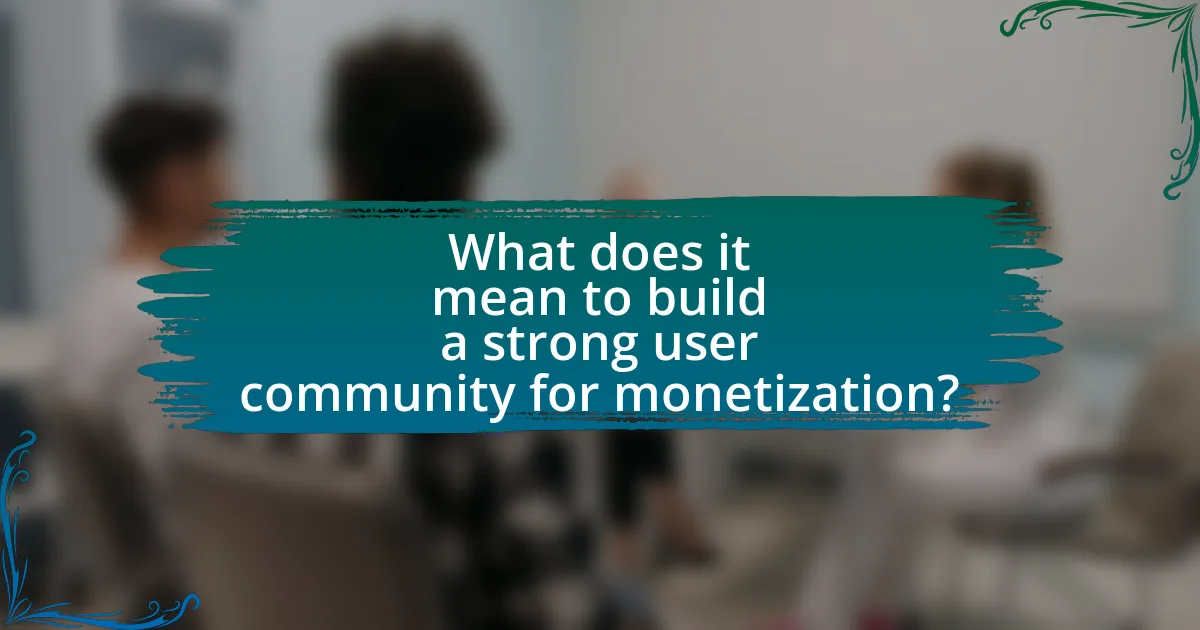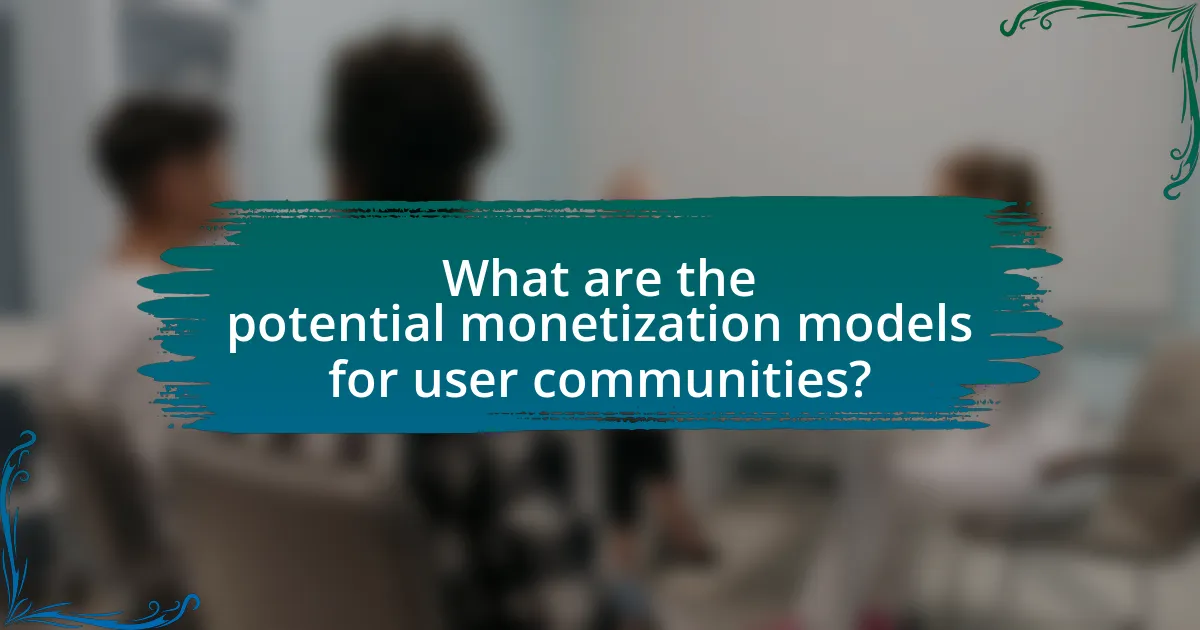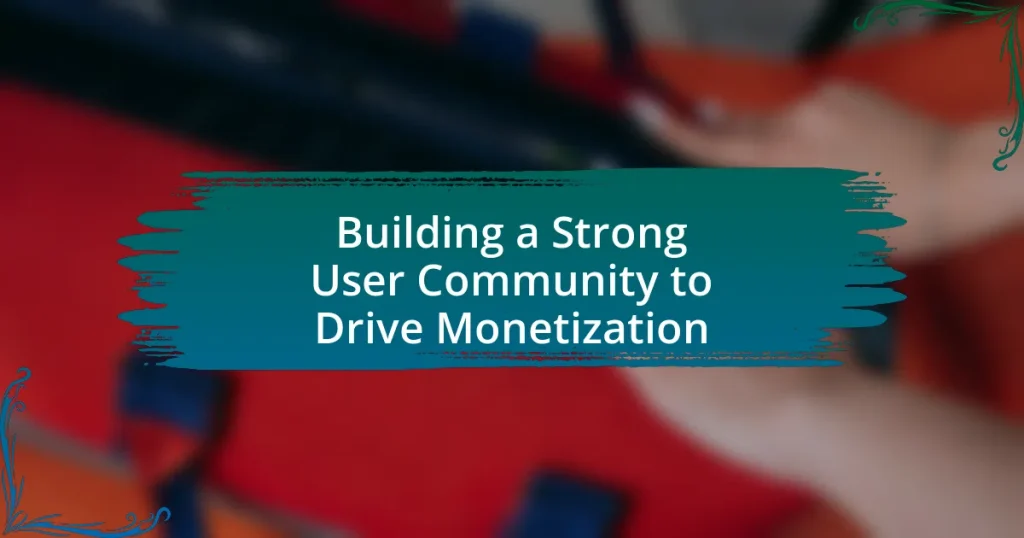Building a strong user community is essential for driving monetization, as it fosters engagement, loyalty, and valuable user-generated content. This article explores how engaged communities enhance monetization strategies through insights, brand loyalty, and subscription models, highlighting successful examples from platforms like Patreon and LEGO. Key elements defining a robust community include trust, shared purpose, and active participation, which significantly influence retention rates and spending behavior. Additionally, the article addresses challenges businesses face in community building, effective strategies for engagement, and ethical considerations in monetization efforts, providing practical tips for leveraging community dynamics to maximize revenue opportunities.

What does it mean to build a strong user community for monetization?
Building a strong user community for monetization means creating an engaged group of users who actively participate and contribute to a platform or service, leading to increased revenue opportunities. This engagement can manifest through user-generated content, referrals, and loyalty, which enhance the overall value of the community. For instance, platforms like Patreon and Discord have successfully monetized by fostering vibrant communities where users feel a sense of belonging and are willing to pay for exclusive content or features. Research indicates that companies with strong user communities can see up to 25% higher customer retention rates, directly impacting their bottom line.
How can a user community contribute to monetization strategies?
A user community can significantly enhance monetization strategies by providing valuable insights, fostering brand loyalty, and generating user-driven content. Engaged community members often share feedback that informs product development and marketing strategies, leading to offerings that better meet customer needs. For instance, companies like LEGO have successfully utilized their user communities to co-create products, resulting in increased sales and customer satisfaction. Additionally, a strong community can drive subscription models or premium memberships, as seen in platforms like Patreon, where community support directly translates to revenue. This symbiotic relationship between user engagement and monetization is evidenced by the fact that businesses with active user communities report higher retention rates and increased lifetime value of customers.
What are the key elements that define a strong user community?
A strong user community is defined by engagement, trust, shared purpose, and active participation. Engagement fosters interaction among members, leading to a vibrant exchange of ideas and support. Trust is crucial as it encourages open communication and collaboration, allowing members to feel safe sharing their thoughts and experiences. A shared purpose aligns the community around common goals, enhancing motivation and commitment. Active participation ensures that members contribute regularly, which sustains the community’s vitality and growth. Research indicates that communities with these elements experience higher retention rates and increased user satisfaction, ultimately driving monetization efforts effectively.
How does user engagement influence monetization outcomes?
User engagement significantly influences monetization outcomes by directly correlating with user retention and spending behavior. High levels of engagement lead to increased user loyalty, which in turn enhances the likelihood of repeat purchases and subscriptions. For instance, a study by the Harvard Business Review found that a 5% increase in customer retention can lead to a 25% to 95% increase in profits, demonstrating the financial impact of engaged users. Additionally, engaged users are more likely to participate in upselling and cross-selling opportunities, further driving revenue. Therefore, fostering user engagement is essential for maximizing monetization potential.
Why is community building essential for businesses?
Community building is essential for businesses because it fosters customer loyalty and engagement, which directly impacts revenue growth. Engaged communities lead to higher customer retention rates; for instance, according to a study by Harvard Business Review, increasing customer retention by just 5% can boost profits by 25% to 95%. Additionally, strong communities facilitate word-of-mouth marketing, as satisfied customers are more likely to recommend products or services to others, further expanding the customer base. Therefore, investing in community building not only enhances customer relationships but also drives monetization through increased sales and brand advocacy.
What role does trust play in community-driven monetization?
Trust is essential in community-driven monetization as it fosters user engagement and loyalty, which are critical for sustainable revenue generation. When community members trust the platform and its creators, they are more likely to participate in monetization efforts, such as subscriptions, donations, or purchasing products. For instance, a study by Edelman found that 81% of consumers need to trust a brand to buy from them, highlighting the direct correlation between trust and financial support. This trust is built through transparency, consistent communication, and delivering value, which ultimately leads to a stronger, more committed community that actively contributes to monetization strategies.
How can a strong community enhance customer loyalty?
A strong community enhances customer loyalty by fostering a sense of belonging and trust among members. When customers feel connected to a community, they are more likely to engage with the brand and remain loyal over time. Research indicates that 70% of consumers are more likely to recommend a brand with an active community, as it creates shared experiences and emotional connections. This engagement leads to increased customer retention, with studies showing that loyal customers are worth up to ten times their initial purchase value over their lifetime.
What challenges do businesses face in building user communities?
Businesses face several challenges in building user communities, including engagement, retention, and resource allocation. Engagement is often hindered by a lack of clear value propositions for users, making it difficult to attract and maintain active participation. Retention issues arise when users do not feel a sense of belonging or connection to the community, leading to high turnover rates. Additionally, resource allocation becomes a challenge as businesses must balance the investment in community management with other operational needs, which can strain budgets and personnel. According to a study by the Community Roundtable, 70% of organizations report that measuring community success is a significant challenge, highlighting the complexities involved in effectively managing user communities.
How can businesses overcome barriers to community engagement?
Businesses can overcome barriers to community engagement by actively fostering open communication and collaboration with community members. This approach includes implementing feedback mechanisms, such as surveys and forums, which allow businesses to understand community needs and preferences. Research indicates that companies that prioritize two-way communication see a 20% increase in community participation, as reported by the Community Engagement Institute. Additionally, providing resources and support for community-led initiatives can empower members, leading to stronger connections and increased loyalty.
What are common pitfalls in community building that affect monetization?
Common pitfalls in community building that affect monetization include lack of clear value proposition, insufficient engagement strategies, and neglecting community feedback. A lack of a clear value proposition can lead to members not understanding the benefits of participation, which diminishes their willingness to invest time or money. Insufficient engagement strategies result in low interaction rates, causing members to feel disconnected and less likely to contribute financially. Neglecting community feedback can alienate members, as their needs and preferences are not addressed, leading to decreased loyalty and support for monetization efforts. These pitfalls collectively hinder the growth and sustainability of a community, ultimately impacting its ability to generate revenue.
How can businesses effectively transition from community building to monetization?
Businesses can effectively transition from community building to monetization by implementing a tiered membership model that offers exclusive content and benefits to paying members. This approach allows businesses to leverage the existing community’s engagement while providing value that encourages users to invest financially. For instance, platforms like Patreon have successfully utilized this model, where creators offer different levels of membership with varying perks, resulting in significant revenue generation. Additionally, businesses can introduce targeted advertising or partnerships that align with community interests, ensuring that monetization efforts resonate with the audience. This strategy not only maintains community trust but also enhances user experience, leading to sustainable revenue growth.
What strategies can be employed to leverage community for revenue generation?
To leverage community for revenue generation, businesses can implement strategies such as subscription models, community-driven content creation, and exclusive member benefits. Subscription models, like those used by platforms such as Patreon, allow users to pay for premium content or services, creating a steady revenue stream. Community-driven content creation, exemplified by user-generated content on platforms like YouTube, can enhance engagement and attract advertisers, thus generating revenue. Additionally, offering exclusive member benefits, such as discounts or early access to products, can incentivize community members to spend more, as seen in loyalty programs by brands like Starbucks. These strategies effectively utilize community engagement to drive monetization.

What are the best practices for fostering a strong user community?
The best practices for fostering a strong user community include creating open communication channels, encouraging user-generated content, and providing consistent engagement opportunities. Open communication channels, such as forums or social media groups, allow users to share their thoughts and experiences, fostering a sense of belonging. Encouraging user-generated content, like reviews or testimonials, empowers users and enhances community involvement. Consistent engagement opportunities, such as webinars or community events, keep users connected and invested in the community. Research indicates that communities with active engagement see a 50% increase in user retention, highlighting the effectiveness of these practices in building a robust user community.
How can businesses encourage active participation within their communities?
Businesses can encourage active participation within their communities by creating engaging platforms for interaction and providing incentives for involvement. For instance, hosting events, workshops, or online forums fosters a sense of belonging and encourages community members to share their ideas and experiences. Additionally, offering rewards such as discounts, exclusive content, or recognition for contributions can motivate individuals to participate actively. Research indicates that communities with strong engagement strategies see a 30% increase in user retention and satisfaction, highlighting the effectiveness of these approaches in driving participation.
What types of content resonate most with community members?
Community members resonate most with authentic, relatable content that fosters engagement and connection. This includes user-generated content, personal stories, and interactive posts such as polls or Q&A sessions. Research indicates that 79% of consumers prefer user-generated content over brand-created content, as it feels more genuine and trustworthy. Additionally, content that addresses community interests, such as tutorials, tips, and industry news, also garners significant attention and interaction, reinforcing the sense of belonging and shared knowledge within the community.
How can feedback loops enhance community engagement?
Feedback loops enhance community engagement by creating a continuous cycle of communication and improvement between community members and organizers. This process allows for real-time input from users, which can lead to more tailored experiences and solutions that meet the community’s needs. For instance, when community members provide feedback on events or features, organizers can quickly adapt their strategies, fostering a sense of ownership and involvement among participants. Research indicates that communities with active feedback mechanisms report higher satisfaction and retention rates, as members feel their voices are heard and valued. This engagement ultimately drives monetization by increasing loyalty and participation in community-driven initiatives.
What tools and platforms are effective for community building?
Effective tools and platforms for community building include Discord, Slack, Facebook Groups, and Reddit. Discord facilitates real-time communication and community engagement through voice, video, and text channels, making it popular among gaming and interest-based communities. Slack serves as a collaboration tool that fosters professional communities, allowing for organized discussions and integrations with other productivity tools. Facebook Groups provide a platform for users to connect based on shared interests, enabling discussions and content sharing among members. Reddit offers a forum-style platform where users can create and participate in discussions on various topics, promoting community interaction and engagement. These platforms have been widely adopted due to their user-friendly interfaces and ability to foster meaningful connections among community members.
How do social media platforms facilitate community interaction?
Social media platforms facilitate community interaction by providing tools for communication, collaboration, and content sharing among users. These platforms enable users to create groups, participate in discussions, and share multimedia content, fostering a sense of belonging and engagement. For instance, Facebook groups allow members to connect over shared interests, while Twitter facilitates real-time conversations through hashtags. According to a Pew Research Center study, 69% of adults in the U.S. use social media, highlighting its role in connecting individuals and communities. This interaction not only strengthens community ties but also enhances user retention and monetization opportunities for platforms.
What role do forums and discussion boards play in community engagement?
Forums and discussion boards serve as vital platforms for community engagement by facilitating communication and interaction among members. These platforms enable users to share experiences, seek advice, and collaborate on common interests, fostering a sense of belonging and community identity. Research indicates that active participation in online forums can lead to increased user retention and loyalty, which are crucial for monetization strategies. For instance, a study by the Pew Research Center found that 73% of online adults engage in forums, highlighting their significance in creating vibrant user communities that drive engagement and, ultimately, revenue generation.
How can businesses measure the success of their community initiatives?
Businesses can measure the success of their community initiatives through key performance indicators (KPIs) such as engagement rates, member growth, and feedback surveys. Engagement rates can be quantified by tracking metrics like the number of active participants, frequency of interactions, and content contributions within the community. Member growth can be assessed by monitoring the increase in community membership over time, indicating the initiative’s reach and appeal. Feedback surveys provide qualitative data on member satisfaction and perceived value, allowing businesses to gauge the effectiveness of their initiatives. According to a study by the Community Roundtable, organizations that actively measure community engagement see a 20% increase in member retention, demonstrating the importance of these metrics in evaluating success.
What metrics should be tracked to assess community health?
To assess community health, key metrics include engagement rate, member growth, retention rate, and satisfaction score. Engagement rate measures the level of interaction among community members, indicating how active and involved they are. Member growth tracks the increase in community size, reflecting its attractiveness and outreach. Retention rate assesses how many members continue to participate over time, which is crucial for long-term sustainability. Satisfaction score, often gathered through surveys, gauges members’ contentment and perceived value of the community. These metrics collectively provide a comprehensive view of community health, essential for driving monetization strategies.
How can user feedback be utilized to improve community strategies?
User feedback can be utilized to improve community strategies by systematically collecting and analyzing input from community members to identify their needs and preferences. This process allows community managers to tailor strategies that enhance user engagement and satisfaction, ultimately driving monetization. For instance, a study by the Nielsen Norman Group found that user feedback significantly increases product usability, which can lead to higher retention rates and increased revenue. By implementing feedback mechanisms such as surveys, focus groups, and user testing, community leaders can make informed decisions that align with user expectations, fostering a more robust and profitable community.

What are the potential monetization models for user communities?
Potential monetization models for user communities include subscription services, advertising, affiliate marketing, merchandise sales, and premium content offerings. Subscription services generate recurring revenue by charging members for exclusive access to content or features. Advertising allows brands to reach targeted audiences within the community, often resulting in significant income based on user engagement metrics. Affiliate marketing involves promoting products or services and earning commissions on sales generated through community referrals. Merchandise sales capitalize on community loyalty by offering branded products. Premium content offerings provide additional value through specialized resources or experiences for a fee. These models are supported by the growing trend of online communities, which have seen a 20% increase in engagement over the past five years, indicating a robust market for monetization strategies.
How can subscription models be integrated into community offerings?
Subscription models can be integrated into community offerings by providing exclusive content, services, or experiences that enhance member engagement and value. For instance, platforms like Patreon allow creators to offer tiered subscription levels, granting subscribers access to premium content, behind-the-scenes insights, or direct interaction with creators. This model not only fosters a sense of belonging but also incentivizes users to contribute financially to the community. Research indicates that communities utilizing subscription models can increase member retention rates by up to 30%, as members feel more invested in the community’s success and sustainability.
What are the benefits of offering premium content to community members?
Offering premium content to community members enhances engagement and loyalty, leading to increased retention rates. Premium content provides exclusive value that incentivizes members to remain active within the community, fostering a sense of belonging. Research indicates that communities with exclusive content see a 30% higher retention rate compared to those without. Additionally, premium content can generate revenue through subscription models, creating a sustainable monetization strategy. This approach not only supports community growth but also aligns with user expectations for high-quality, tailored experiences.
How can businesses create tiered membership levels for monetization?
Businesses can create tiered membership levels for monetization by defining distinct benefits and pricing structures for each tier. This approach allows businesses to cater to varying customer needs and willingness to pay, enhancing user engagement and retention. For instance, a company might offer a basic tier with essential features, a mid-tier with additional perks, and a premium tier that includes exclusive content or services. Research indicates that tiered pricing can increase revenue by up to 20% as it attracts a broader audience and encourages upselling. By clearly communicating the value of each tier, businesses can effectively drive monetization while fostering a strong user community.
What role do partnerships play in monetizing user communities?
Partnerships play a crucial role in monetizing user communities by providing access to additional resources, expertise, and audiences that enhance revenue opportunities. Collaborations with brands or service providers can lead to co-branded products, exclusive offers, or affiliate marketing programs, which directly generate income. For instance, a study by the Community Roundtable found that organizations leveraging partnerships reported a 30% increase in revenue from community-driven initiatives. This demonstrates that strategic alliances not only expand the community’s value proposition but also create diverse monetization channels, ultimately driving financial success.
How can collaborations enhance value for community members?
Collaborations enhance value for community members by pooling resources, expertise, and networks, which leads to increased opportunities and benefits. For instance, when local businesses partner with community organizations, they can offer joint events or promotions that provide members with exclusive access to services or products, thereby fostering a sense of belonging and engagement. Research indicates that collaborative efforts can increase community participation by up to 30%, as seen in initiatives like community gardens or local festivals, which not only strengthen social ties but also stimulate local economies.
What types of partnerships are most effective for community monetization?
Strategic partnerships with local businesses, brands, and content creators are most effective for community monetization. These partnerships leverage mutual benefits, such as cross-promotion and shared resources, which can enhance visibility and engagement within the community. For instance, collaborations with local businesses can provide exclusive discounts or offers to community members, incentivizing participation and loyalty. Additionally, partnerships with content creators can lead to sponsored content or affiliate marketing opportunities, generating revenue while providing value to the community. Research indicates that communities with strong local business ties see a 20% increase in member engagement, which directly correlates with higher monetization potential.
What are the ethical considerations in monetizing user communities?
Monetizing user communities raises several ethical considerations, primarily centered around user consent, transparency, and the potential for exploitation. User consent is crucial; community members should be fully informed about how their data will be used and how monetization efforts may impact their experience. Transparency involves clearly communicating the monetization strategies employed, such as advertising or subscription models, ensuring users understand the implications of these strategies on their engagement and privacy. Additionally, there is a risk of exploitation, where community members may feel pressured to participate in monetization efforts, such as purchasing products or services, which can undermine the trust and authenticity of the community. Ethical monetization practices should prioritize user welfare and foster a sense of belonging rather than prioritizing profit at the expense of the community’s integrity.
How can businesses maintain transparency with community members?
Businesses can maintain transparency with community members by regularly sharing information about their operations, decisions, and policies. This can be achieved through open communication channels such as newsletters, social media updates, and community meetings, which allow for real-time feedback and engagement. For instance, a study by the Harvard Business Review found that companies that prioritize transparency see a 30% increase in customer trust and loyalty, demonstrating that clear and honest communication fosters stronger relationships with community members.
What practices ensure that monetization efforts do not alienate users?
To ensure that monetization efforts do not alienate users, companies should prioritize transparency, user feedback, and value-driven approaches. Transparency involves clearly communicating monetization strategies, such as subscription models or in-app purchases, which helps users understand what they are paying for and why. User feedback mechanisms, such as surveys or forums, allow users to express their concerns and preferences, enabling companies to adjust their strategies accordingly. Additionally, providing real value through monetization—such as exclusive content or enhanced features—ensures that users feel their investment is justified. Research indicates that 70% of users are more likely to remain loyal to a brand that actively seeks and incorporates their feedback into product development, demonstrating the importance of user engagement in monetization strategies.
What practical tips can businesses implement to build and monetize their user communities?
Businesses can build and monetize their user communities by fostering engagement through interactive platforms, offering exclusive content, and implementing tiered membership models. Engaging users on platforms like forums or social media encourages participation and loyalty, which can lead to increased retention rates; for instance, companies with active user communities report up to 50% higher customer retention. Providing exclusive content, such as webinars or premium resources, incentivizes users to invest in the community, enhancing perceived value. Additionally, tiered membership models allow businesses to monetize by offering varying levels of access and benefits, which can increase revenue streams; research shows that 70% of subscription-based businesses see higher profits from tiered memberships.


